Mark Sisson's Blog, page 186
April 13, 2017
“What’s That?” Ear Health: Dietary and Lifestyle Choices that Preserve It
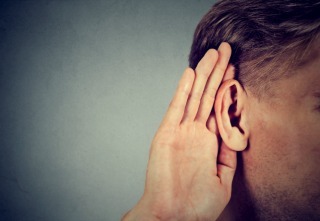 Sure, they’re not exactly the sexiest body part, but it’s fair to say that life with substandard ear health would be notably less enjoyable. And as it happens, millions of Americans would be able to speak to that.
Sure, they’re not exactly the sexiest body part, but it’s fair to say that life with substandard ear health would be notably less enjoyable. And as it happens, millions of Americans would be able to speak to that.
Research indicates that an estimated 1 in 5 folks have some form of hearing loss. This rate increases to 1 in 3 for age 65 and over, but some estimates put hearing loss great enough to impair communication even higher for the upper decades at around 40%. Perhaps even more alarming, close to 15% of American kids have some form of hearing loss. In teenagers, prevalence has jumped from 15% in 1994 to almost 20% in 2006. Unfortunately, that hearing difficulty will often go undiagnosed.
Hearing loss is, in fact, the third most common health condition in the country, right on the heels of arthritis and heart disease. And it’s getting worse. Between 2000 and 2015, the number of Americans with hearing loss has doubled, mirroring a worldwide increase of 44% over that same period.
But it’s not all about hearing. What about ear health? Our ears perform plenty more functions than just auditory reception. Let’s not forget that the ears are instrumental in influencing our emotions and state of mind, maintaining our sense of balance, and regulating pressure.
From what meagre stats are available on ear health, we know that close to 16,000 older Americans were killed in falls in 2005. We also know that nearly half of those deaths were balance-related. And that a whopping third of the population report vestibular symptoms (inner ear-related balance issues). Ménière’s disease, a disorder of the inner ear that causes tinnitus, vertigo and hear loss, affects an estimated 615,000 Americans. That’s enough in the way of statistics to indicate that substandard ear health has broad implications for overall health.
Noise Annoys: Let Natural Sound Abound
There’s plenty of mechanisms by which our bodies recognize stress. One such mechanism that often gets overlooked is our ears. At a very basic, primitive level, the sounds registered by our ears dramatically impact our emotions. Birdsong, in particular, and trickling water relax our minds and alleviate stress, while the neighbor’s yapping dog or traffic noise from the street rile us up. This lines up with what we know about the all-important vagus nerve, which plays an influential role in how our bodies control inflammation…and which just so happens to have a few tendrils in your ears.
Along with all the conveniences of the modern world, the Grok-friendly natural sounds of the past have slowly been replaced by anthropogenic noise. Cars, planes, trains, incessant chatter… noise constantly surrounds us, and while it may fade into the background, research shows that it’s slowly but surely contributing to chronic stress.
A 2014 literature review of the effects of noise on health noted that it disturbs sleep (duh), increases the occurrence of hypertension and cardiovascular disease, and impairs cognitive performance.
And by triggering stress and the subsequent release of adrenaline, noise can create a negative feedback loop which worsens the health of your ears. Elevated levels of adrenaline lower blood circulation in the peripheral areas of the body, one of which just so happens to be the ears. With chronic stress, the tiny hairs inside your ear canals become starved of blood and the nutrients it provides. The result is a gradual die-off of these auditory hairs, which of course can lead to permanently impaired hearing. This means that noises that might not directly damage your ears can still harm your hearing.
On the brighter side, nature is the best antidote. Getting away from the urban jungle and immersing ourselves in the sounds of nature has been shown to reduce our perception of pain. A similar therapeutic effect is highlighted by this 2003 study, which modeled the stress-buffering effect that “nearby nature” had on schoolchildren. Unsurprisingly, researchers found that “the impact of life stress was lower among children with high levels of nearby nature than among those with little nearby nature.” The science behind restorative natural sound is largely rooted in evolutionary principle. Our inherent blueprints expect the subtle “aural diet” of our ancestors rather than the bombastic range of noises we feed it today.
Hearing Loss: More to It Than Many Believe
I’ll start with the obvious: if your ears are exposed to loud noises, you may suffer from temporary hearing loss. But newish research published in the Journal of Neuroscience suggests that it may not be over even after the concert’s over. According to the study, “acoustic overexposures causing moderate, but completely reversible, threshold elevation leave cochlear sensory cells intact, but cause acute loss of afferent nerve terminals and delayed degeneration of the cochlear nerve.” This means that going to a one-off music concert, for example, might set in motion a degenerative process which can damage your hearing permanently. Scary stuff.
And as the research into hearing loss begins to accumulate, it’s becoming increasingly apparent that ear health is intrinsically tied into your overall health. For starters, smoking has been directly linked to hearing loss. A 2007 study found that newborns who were exposed to tobacco smoke in the womb had a significantly lower hearing sensitivity than those who weren’t. Obviously, if you’re a Primal lifer you’ve long ago washed your hands of the Marlboros, but second-hand smoke is always a risk to pregnant mothers, no matter how healthy they are. Yet another reason to distance yourself from those noxious clouds…
Another sobering fact—there’s also plenty of evidence showing that diabetes can contribute to hearing loss. Researchers from the University of Maryland School of Medicine examined medical records from 53,461 non-diabetic patients and compared them 12,575 age-matched diabetic patients. They found that sensorineural hearing loss was more common in the diabetic patients, and that this hearing loss impact increased with elevated diabetes severity. Other studies have found much the same correlation, with some indications noting that perception of higher sound frequencies might be the first to go.
The Role of Diet for Hearing
Yes, as with everything else, what you eat (or don’t eat) affects your ear health. Apparently, restricting calories is the new big thing in the ear world. A recent Swedish study proved that rats placed on a 70% dietary restriction showed reduced age-related degenerative shrinking of their inner ear tissues. This resulted in significantly improved hearing function over non-calorie restricted littermates.
For those of us interested in less extreme measures, there are other promising dietary strategies to consider. Multiple studies have shown that a diet rich in the vitamins A, C, E and magnesium can prevent hearing loss by minimizing inflammation and increasing blood flow to the inner ear. Crucially, however, none of these vitamins or magnesium alone were effective in reducing hearing loss or sensory cell death: only when applied synergistically did they provide the protective effect (kind of like the A Team of the hearing world). Specifically, their collective effect helped to protect the ear against the negative feedback degenerative hearing damage I discussed earlier.
And there’s plenty more research where that came from. This study used sound frequency testing and a semi-quantitative questionnaire to establish what impact intakes of certain vitamins and minerals exhibited on hearing health. Vitamins A and E showed the most promise, with vitamin A correlating with a 47% lower risk of hearing loss and vitamin E a 14% lower risk. I like those odds but, again, believe that synergy matters.
The role of magnesium in hearing protection has received particular attention in the literature, and the results continue to be positive. If you’ve got hearing problems and haven’t already invested in the formidable healing powers of quality magnesium supplementation, now might be the time.
So while the rest of the world waits for the development of wondrous oral drugs that capitalize on these findings, here’s an insider’s tip: you can get a head start by simply eating wholesome, nutrient-dense foods. Nothing new there, right? Dark leafy greens for magnesium, avocados for vitamin E, liver for vitamin A, and any number of fruit and vegetables for vitamin C. A comprehensive multi can’t hurt either.
Unpacking the Mystery of Tinnitus
Then there’s tinnitus, the frustrating ringing ear condition that regularly affects an estimated 15% of Americans. As far as causes go, the list is long. In addition to noise exposure, tinnitus can develop as a result of excessive ear wax buildup, medications like aspirin and antibiotics, middle ear infections, and aging. Tinnitus occurs when hair cells in the ear’s cochlea are damaged or destroyed, meaning there are any number of pathways by which someone can develop this condition. I have a friend who’s suffered from tinnitus over the past 5 years due to multiple concussions. Ding your head enough times, and your ears may pay the price. There’s even suggestions that certain folks may be genetically predisposed to developing tinnitus, but that research isn’t conclusive.
And despite our growing knowledge of the causes of tinnitus, it’s on the rise. As the urban population grows, so, too, does the percentage of the population exposed to that anthropocentric din I highlighted earlier. Concerts are just as big and loud if not more so than they were a couple decades ago. We have more and noisier machines in our lives than ever before.
But it’s not all doom and gloom. Those same hearing-protective steps I talked about earlier can also be applied to tinnitus. Concentrating on nutrient-dense foods that provide ample levels of vitamins A, C and E, and perhaps supplementing with magnesium oil, should help to prevent those hairs in your cochlea from sustaining significant damage. Continuing the diet theme, there’s preliminary evidence to suggest that zinc depletion may play a role, and that moderate to high caffeine intake per day has beneficial effect. Probably not a great idea to go crazy on the coffee, however, particularly if you’re sensitive to it.
And, not suprisingly, Inflammation is almost undoubtedly at play here as well, verified by a strong association between hypertension and tinnitus. Reducing inflammatory food intake and minimizing stress should therefore go a long way towards lowering your risk of tinnitus. Similarly, vagal nerve stimulation, which uses small electrical pulses to stimulate an anti-inflammatory feedback in the vagus, shows a lot of promise in treatment for tinnitus.
Thanks for reading, everyone. Have you or those you love experienced any of the above conditions? Are you taking any special steps to preserve your hearing and ear health? Have you heard about other medical treatments or lifestyle interventions? Have a good end to your week.
The post “What’s That?” Ear Health: Dietary and Lifestyle Choices that Preserve It appeared first on Mark's Daily Apple.



April 12, 2017
7 Primal Mantras to Drive Your Success
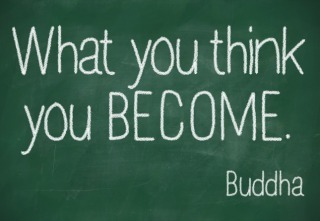 D0 you have any mantras? You should.
D0 you have any mantras? You should.
Ignore the pseudo-spiritual baggage many people have with the notion of a mantra. Repeating and focusing on a meaningful phrase to help guide you through difficult situations, whether that’s an hour of sitting meditation or a commitment to a healthy Primal lifestyle, is a legitimate tool anyone can use. Today, I’m going to give you 7 mantras that I find to be useful.
Many of these don’t even apply explicitly to nutrition or fitness, so anyone can gain from incorporating them. I even left off a personal mantra of mine—”Rend the flesh of young mammals and consume it close to raw as possible”—to make vegetarians and vegans feel more welcome.
Let’s go:
Pay yourself first.
In business, the single best piece of advice I ever received was to invest in myself. That meant furthering my education, improving my health, taking the opportunity to get some extra sleep, and even taking calculated risks in business to either succeed outright or fail but learn something new.
This worked out beautifully. I buckled down on nutrition and science. I figured out what was causing my health issues, and enacted the right changes to my diet, exercise, and lifestyle to solve them. And I took a ton of risks, including giving up a cushy job to start Primal Nutrition. All these self payments led to the life I now lead.
Take care of yourself first and the benefits emanate outward. You could nag your friends about giving up fast food and get nowhere, or you could focus on optimizing your own eating habits and let the results speak for themselves.
If it were easy, everyone would do it.
Primal living is simple. Yes, you can geek out on the nitty-gritty details. Yes, you can chase optimization and hack the hell out of everything. But the true power of this way of life lies in its simplicity. Eat well, sleep lots, get light at the right times, move your body.
It’s not easy, though. If it were, everyone even remotely cognizant of alternative health would be fit, healthy, strong, and happy. They aren’t, so it’s not.
Know that you’re a warrior for doing a hard thing. Take pride in that, because you’ve earned it. Also know that you’re going to slip up from time to time, and that it’s okay—so long as you get up and keep doing the hard thing.
Think of “If it were easy, everyone would do it” as both a pressure release valve and a motivational tool. It provides relief for those times we inevitably slip up and mess up, and it makes you feel awesome for doing something few can or will.
Vicarious living isn’t.
Ross, from a recent (and incredible) success story, inspired this one. Hat tip to you, Ross.
First off, I think we accuse people of vicarious living in the wrong way. When someone loves watching their children excel at sports or the arts, are they living vicariously in a futile attempt to mask their own miserable excuse for a life, or are they supporting their loved ones and feeling pride? I’d argue the latter.
When people spend every ounce of free time watching reality TV, catching up on the news, bingeing on Netflix, and generally thinking about what other people are doing (or pretending to do) rather than doing anything themselves, that’s vicarious living. True living doesn’t even have to be TV-worthy. We can’t all parachute from planes into enemy territory or drive trucks through frozen wastelands along rickety cliff roads. But we can all do something other than think/care/watch other people doing things. Hell, how many people watch hours of Food Network and never set foot in their own kitchens?
Onward and upward.
Things don’t always work out. You won’t always work out, even though you told yourself you would. “Onward and upward.” You’ll get it next time.
It applies every time.
Failed miserably? Onward and upward.
Personal setback? Onward and upward.
Fell flat on your face? Onward and upward.
The mistake, failure, or whatever moment you’re currently lamenting has passed. It no longer exists. Meanwhile, you’re hurtling toward the future moment where you can make amends and fix the mistake, right the wrong. That moment is now.
Leave a rep in the tank.
I tell myself this all the time. This really comes in handy for those moments where my gut tells me not to lift something, but my ego’s urging me to push through the reluctance and get the rep. I firmly believe that those hints from our subconscious are warnings against injuries. “Leave a rep in the tank” helps defeat the ego and avoid injury.
Reps are metaphorical. It applies to anything in life. For example, Hemingway would stop writing for the day when things were going well and he had plenty more to write. He wouldn’t “go to failure.” This allowed him to come back the next day and pick up where he left off.
Excuses always betray you.
Excuses serve no purpose other than making you feel better in the moment. You made a mistake. You failed to do something you should have done. Instead of staying with the realization and learning from it, you shut down the mental feedback circuit with an excuse. You’ve cut off the opportunity for self-reflection and insight.
Excuses absolve you from the burden of responsibility, and without responsibility, we behave badly. Responsibility tethers us to reality—and nurtures opportunity to grow beyond where we’re at.
As you approach the runway, ready to launch your excuse, remember these words: “Excuses always betray you.”
This, too, shall pass.
All situations are transient. All physical possessions will eventually stop working, lose their luster, or be forgotten. All emotional states are subject to change. Nothing stays the same forever. Things fall apart.
When you’re in the middle of a tough set of heavy squats, and you come back up from the 3rd rep of 5 and think you can’t possibly bear it, know that “this too shall pass.”
When you’re dealing with the death of a family member or a breakup, and it feels like the pain won’t ever stop, remember the mantra. Your heart might not feel it, but your brain can acknowledge the fact that this too shall pass.
This goes for good feelings and positive situations, too.
This body? It won’t stay this lean, strong, and fit forever. Better enjoy it and keeping using it, or you’ll lose it.
The awesome night you’re having with friends and several bottles of wine? This, too, shall pass (and it might feel very different in the morning).
Whatever it is, this, too, shall pass, so savor it. Enjoy it. But don’t become too attached—or despairing.
Those are some mantras I’ve found helpful on my Primal journey. What about you? What mantras do you apply? Thanks for reading, everybody. Take care.
The post 7 Primal Mantras to Drive Your Success appeared first on Mark's Daily Apple.



April 11, 2017
The Primal Health Coach Certification Program Keeps Getting Better and Better
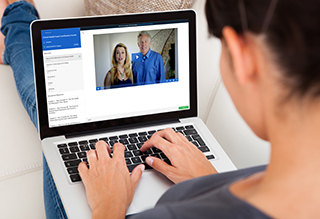 There’s something to be said for embarking on a path and then staying open when the road branches off in different directions. That feels like an apt metaphor for my career. I was always in touch with my passion and purpose: pursuing entrepreneurial endeavors in the field of health and wellness to activate positive and persistent change in as many lives as possible. But the exact unfolding of my career path has been a continual and welcome surprise.
There’s something to be said for embarking on a path and then staying open when the road branches off in different directions. That feels like an apt metaphor for my career. I was always in touch with my passion and purpose: pursuing entrepreneurial endeavors in the field of health and wellness to activate positive and persistent change in as many lives as possible. But the exact unfolding of my career path has been a continual and welcome surprise.
These past few years especially, my business has branched out to all different avenues…book publishing, nutritional supplements, educational diet and exercise systems, a successful condiment company, a franchise of restaurants…but at the heart of all of my endeavors is my passion for spreading the Primal way of life across the globe.
After my career as a pro endurance athlete and before I started blogging here at Mark’s Daily Apple, I transitioned to a fitness and health coaching career and saw firsthand how providing one-on-one wellness support could effect dramatic change in the lives of people who had all but given up on living a vibrant, healthy life.
Impacting people on a personal level is what I’m all about, but I wanted to reach more people than was possible working one-on-one with clients within the constraints of a 24-hour day and 40-hour workweek. So, I started Mark’s Daily Apple to help elevate the paleo and Primal conversation onto a more expansive platform. And it worked. People actually read what I had to say. The Primal message reached millions, and helped an untold number of people take control of their health and their lives.
But then the road revealed yet another path. There was more that could be done. I am only one man, but what if I could collaborate with all you Primal enthusiasts out there to help spread the Primal message and heal the health of the world? What if I could help create a global network of Primal Health Coaches to transform the health and consciousness of communities into ones of optimal wellness and happiness through ancestral health? That’s why I started the Primal Health Coach program—to train other health motivators to inspire change.
I launched the program last year to remarkable success, and I’m thrilled to say thousands of people have taken up the banner for Primal pursuits across the world. Here are just a few of their beautiful faces:

I love hearing from Primal Health Coach graduates to see where they’re at in their career pursuits and how the program has helped them.
The Primal Health Coach program provides a concise platform of knowledge that I pass on to my personal training clients and colleagues. It has given me the confidence to help people in ways beyond the fitness industry. Simply put, I am a more well-rounded trainer and health coach because of my experiences with Primal Health Coaching.
– Josh Holland
The Primal Health Coach program expanded my access to and credibility with people who embrace Primal principles but may not have considered holistic medicine, enhancing my practice and extending my professional reach.
Completing the Primal Health Coach program has proven to be an invaluable asset to my coaching practice. I’m so much more prepared to explain the benefits of a Primal lifestyle to my clients and coach them as they take their health, fitness, and performance to a higher level than ever thought possible.
– James Arthur
The Primal Health Coach program is a comprehensive training package that has helped solidify my knowledge of the Primal philosophy as well as how to eat and train in general. In the start-up phases currently, I know that the information and coursework I learned from the Primal Health Coach program will allow me to help others and give them alternatives to the Standard American Diet approach. The added sales and client information are the icing on the cake to take the information and put it to use in helping others.
– Jeff Pickett
I wanted to thank you for putting together the business materials and the 90-day program. Within a few days of that being published for us, I booked my first 2 clients (I started going to a gym and the owner will literally call me over while he is on-boarding people!!!). I’ve told you before that I struggle with organizing things and need a structure to follow, then I’m good. Well, it was enough for me to jump in.
– Mike Bruce
In the last year, my team and I have paid close attention to requests from our students and graduates. We’ve listened carefully to their feedback, so we can continue to make improvements to the program—improvements that will provide them with everything they need to run successful businesses as Primal Health Coaches and get their clients the results they desire. Today, I’m excited to announce that we’ve recently released several major program updates.
The new and improved Primal Health Coach Learning Center features:

New Learning Management Platform – We’ve redesigned our learning hub so that you can move through the coursework and examinations simply and easily from the comfort of your home, and on any device (computer, tablet, mobile phone). Once a student, you have lifetime access to the coursework.

New/Updated Coaching Coursework – My goal has always been to train the most effective coaches and set them up with thriving health-coaching businesses from start to finish, so we’ve expanded our coaching education courses and lead you through the ins and outs of operating a successful practice. Master Coach Christine Hassler walks you through training videos that bolster confidence, help you secure clients and brand your business with an online presence, and arm you with both coaching and sales strategies. Every lesson features supportive text, audio additions, and ready-made PDF handouts for you to use in your business.
A New Primal Health Coach Business Resource Center – The nucleus of your health coaching business, with all the tools, forms, educational handouts, logos, graphics, and guidance you need to kickstart your health coaching business and keep it running full steam ahead. We motivate and inspire with business-building tips, rates and programming advice, legal and insurance considerations, coaching strategies for the many different personalities you will encounter, suggestions for earning passive income and making the most of your health coaching certification, and so much more. The learning never stops, and the support keeps on coming.

A New Step-by-Step 12-Week Program – You’ve worked hard with a deep dive into ancestral health, and now you can hit the ground running with a done-for-you program you can use in your practice. No more guesswork. And no struggling through months of program prep. You can immediately and confidently launch your health coaching business knowing you have a sure-fire and customizable regimen to use with clients. We’ve got you covered every step of the way.
A New and Improved “Find a Coach” Directory – As a graduate of the program you’ll have the option of creating a public profile on PrimalHealthCoach.com. Being listed in the directory is a great way to attract new clients.
And we’ve included numerous other updates and improvements, all designed to build better coaches.
I wanted to let you know about these updates in case you or someone you know has been thinking about a health coaching career and is excited to help others onto the Primal path.
As a thank you for your loyalty and passion for Primal, we’re offering $100 off the program until April 17th. Just call us at 844-307-7662 and refer to code “FRIENDOFMDA.”
You can also head on over to PrimalHealthCoach.com where you can sign up to watch an exclusive Info Session Video I made for you, or download a free Primal Health Coach Guidebook that will answer any additional questions you may have. All you have to do is subscribe, but there’s absolutely no commitment.
Finally, you can talk to one of my team members at 844-307-7662 if you have any questions.
What are the next steps on your career path? I’d love to have you join me on my mission to change the world one wellness wish at a time.
The post The Primal Health Coach Certification Program Keeps Getting Better and Better appeared first on Mark's Daily Apple.



It’s the Biggest Paleo Event of the Year: Paleo f(x) 2017!
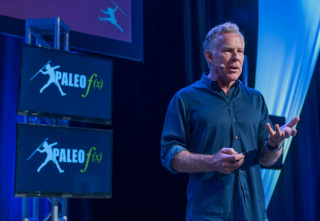 Paleo f(x), my favorite holistic health and fitness event in the world, returns to Austin May 19-21, 2017! In case you missed it the last 4 years, Paleo f(x) is the Who’s Who gathering of the ancestral health movement. I’ll be giving some talks, and you’ll also be getting deep inside the brains of other world-class speakers including New York Times bestselling authors, physicians, scientists, athletes, health entrepreneurs, fitness professionals, biohackers, and more. Robb Wolf will be joining me, along with Chris Kresser, Dr. Sarah Ballantyne, Dr. Kellyann Petrucci, Ben Greenfield, Sarah Fragoso, Art De Vany, John Durant, Emily Schromm, and dozens upon dozens more. You can register for the event and see a full list of speakers here.
Paleo f(x), my favorite holistic health and fitness event in the world, returns to Austin May 19-21, 2017! In case you missed it the last 4 years, Paleo f(x) is the Who’s Who gathering of the ancestral health movement. I’ll be giving some talks, and you’ll also be getting deep inside the brains of other world-class speakers including New York Times bestselling authors, physicians, scientists, athletes, health entrepreneurs, fitness professionals, biohackers, and more. Robb Wolf will be joining me, along with Chris Kresser, Dr. Sarah Ballantyne, Dr. Kellyann Petrucci, Ben Greenfield, Sarah Fragoso, Art De Vany, John Durant, Emily Schromm, and dozens upon dozens more. You can register for the event and see a full list of speakers here.
I had such a great time rubbing elbows with thousands of like-minded Primal/Paleo enthusiasts at last year’s Paleo f(x). The Palmer Events Center featured all the biggest companies in the ancestral health sphere along with over 30 expert speakers. Overall, there wasn’t a dull moment, an empty belly, or a lack of enthusiasm among the pop-up community of Primal/Paleo attendees.
2017 promises to be even more of a thrill. The event features:
Keynotes: Be empowered and inspired by the thought leaders of the wellness movement at the keynote stage talks. (You’ll find me in this crew.)
Workshops: Work live with coaches and fitness experts at the small group expo floor workshops. Master your squat, conquer your kettlebell swing, or have fun at a “Primal Playout.”
Cooking Demos: Learn new mouth-watering Paleo recipes, up close and personal with your favorite bestselling cookbook authors and foodie bloggers.
Paleo On-Ramp: The special beginner-friendly stage has “Paleo 101” level talks that gently introduce you to real food and optimal living.
Health Expo: Discover an array of health-conscious, paleo-friendly companies and sample delicious foods on the expo floor.
Paleo f(x) FitScore: What is your overall fitness level? Accurate, cutting-edge, and safe, The Paleo f(x) Fit Score was designed by experts, and certified by realFit, to help you answer this question.
Book Signings: Meet all your favorite authors and speakers at book signing meet and greets.
Networking: Connect with entrepreneurs, creatives, and other passionate “builders” in the Paleo f(x) networking lounge. Includes special guided networking sessions for bloggers, fitness professionals, and health practitioners. If mingling isn’t your thing, Paleo f(x) also offers special guided networking sessions. You’ll be matched with 8-12 other attendees who share your similar interests, so there’s no way you’ll leave without making personal and lasting relationships with your paleo/Primal tribe.
Special Events: Celebrate the community at the Paleo Magazine Awards, and join us for the Saturday Night Charity Festival.
[image error]
I’ll also be walking the ground floor for the entire event, so it’s a great chance for us to meet. Or catch me at my talk, when I’ll discuss the Primal importance of finding an avocation that excites you. I’ll share a bit about my own long and circuitous path to building my Primal businesses and offer some insight into how to discover hidden opportunities that can change your life.
Paleo f(x) takes place at the Palmer Event Center, a premier space in downtown Austin, adjacent to the city’s best food, music, and culture. Last year our Primal presence filled the streets, pervading every corner of Austin for the weekend.
Tickets have sold out the last 4 years, so be sure to register today!
Check out the website to learn more about why you won’t want to miss this opportunity.
I look forward to seeing you in May!


The post It’s the Biggest Paleo Event of the Year: Paleo f(x) 2017! appeared first on Mark's Daily Apple.
 [image error]
[image error]

April 10, 2017
Dear Mark: Coffee Alternatives for Liver Health, Vitamin C, Gelatin vs Collagen, NAC, My Favorite Way to Cook Greens, and Potato Starch Breading
 For today’s edition of Dear Mark, I’m answering several questions. First, if a person can’t have coffee but wants the benefits it provides to liver health, what else can they try? Next, what role does vitamin C play in glutathione production? Then, I explore how gelatin and collagen differ from each other, followed by a quick description of NAC. After that, I give my current favorite method for cooking greens, and end with a discussion of how breading meat with potato starch changes the meal.
For today’s edition of Dear Mark, I’m answering several questions. First, if a person can’t have coffee but wants the benefits it provides to liver health, what else can they try? Next, what role does vitamin C play in glutathione production? Then, I explore how gelatin and collagen differ from each other, followed by a quick description of NAC. After that, I give my current favorite method for cooking greens, and end with a discussion of how breading meat with potato starch changes the meal.
Let’s go:
What is it about coffee, exactly, and can you get the same effect from other foods? Coffee is out for me because I am so highly sensitive to caffeine.
For one, coffee is the primary way we get our antioxidants and polyphenols. You’ve got the satin-pantsed, Tao Te Ching-quoting set eating half their weight in goji berries and the paleo set binging on 99% dark chocolate, but most Westerners get the majority of their polyphenols through coffee. That’s true for Japan, Spain, Poland, and many other countries.
Two, caffeine itself has hepatoprotective effects.
Anything with caffeine is out for you. So, tea won’t work either. You need to look for things with polyphenols known to improve liver health. Luckily, many exist.
Decaf may work. One study found that people who drank decaf had lower liver enzymes, though a more recent study found that caffeinated but not decaf was associated with lower rates of liver cancer. Both studies are observational and thus limited in impact. But decaf is generally quite good for the liver. At worse, it’s neutral.
Anything purple/blue/black will help. Those colors indicate high levels of polyphenols, and things like blueberries and purple potatoes, which are high in these colorful polyphenols, show clear hepatoprotective effects. When rats are given a toxin that normally produces liver damage, blueberry protects them. When healthy white adults with borderline hepatitis drink a purple sweet potato beverage every day for 8 weeks, their liver enzymes improve.
Chocolate is good, too. Go for the dark stuff with high cacao content. Studies—albeit mostly in vitro ones—suggest a protective effect. When liver cells are exposed to celecoxib (the active drug in Celebrex), which can cause liver cancer, adding cocoa extract protects them by preventing apoptosis and inducing autophagy. In existing cancer cells (lung, in this case), however, cocoa increases apoptosis and protects against progression.
That’s a good start. Tough to go wrong with any of those.
What about Vitamin C supplementation? I understand it is necessary to help your body generate glutathione.
Can’t believe I forgot about vitamin C. Thanks for reminding me.
Yes, vitamin C can boost glutathione production, particularly if you’re already deficient. For instance, one study took subjects with verified vitamin C deficiency, gave them extra vitamin C, and tracked the glutathione content of their white blood cells. It went up. This is really important, because white blood cell glutathione protects the cells from free radical damage as they go about their business protecting us from immune insults.
I only knew about muscle meat, I didn’t know about the eggs! Also, I’d like to know if gelatine works or if collagen would be better. Thanks!
They have the same effects once you ingest them. Gelatin needs to be dissolved in hot liquid (unless you like choking down powder that coats your throat), while collagen hydrolysate dissolves in cold liquid.
What is NAC
N-acetyl-cysteine. A fairly common supplementary source of cysteine that upregulates glutathione production.
I would like to see some new recipes for cooked greens.
This was a response to my request for ideas for the blog. More are coming, but here’s a quick one I really like:
Get several fistfuls of red kale. This is the heartiest variety, in my opinion. You can treat it almost like collards. Chop it up into 1 inch strips.
Sauté chopped garlic and shallots, and maybe some chile peppers, in the fat of your choice. I either use butter, avocado oil, or olive oil.
When the garlic/shallots are soft and thinking about browning, toss in the kale. Sauté that until slightly wilted. Add salt and pepper.
When the garlic/shallots begin to brown, drop in a big gob of extremely gelatinous bone broth. Personally, I find that most store bought bone broths don’t cut it. You either have to make it yourself, or find a premium bone broth dealer (for what it’s worth, this one is my favorite).
Reduce the broth with the cover off. The key is timing it so the broth reduces into syrup just as the kale reaches optimal consistency.
Finish with some fresh lemon juice.
If you don’t want to mess with chopping garlic, shallots, and chiles, garlic powder and cayenne work well.
In my experience, even ornery toddlers and extreme supertasters will eat this stuff.
I’ve left another comment, but thought of this: I often cover meat in potato starch and fry them, making a sort of breading. Is that a bad, good, or neutral thing to do?
Frying potato starch will create acrylamide, a potential carcinogen. French fries and potato chips are some of the foods highest in acrylamide, which may partially explain why eating lots of them tends to correlate with poor health. You can reduce its formation, though. Certain spices and plants like clove extract and grape polyphenols inhibit acrylamide formation during the cooking of starches. Rosemary, too, can reduce it. I’d imagine other antioxidant-rich plants, herbs, and extracts would have similarly inhibitory effects. Next time you prepare your potato starch breading, include some ground rosemary.
You’re going to absorb more of the cooking fat, which will increase the amount of energy you take in. Frying at lower heats absorbs more oil, so stick to higher heat for short bouts.
You’re also going to increase the carb content. Not by much, but by some. Next time you do this, measure how much potato starch you use and how much actually ends up on the meat. A tablespoon of potato starch has 10 grams of carbs, or 40 calories.
You won’t get any resistant starch (unless you lick the dredging plate). Applying any significant heat to potato starch destroys the resistant starch entirely.
Thanks for reading, folks. If you’ve got anything to add, do so down below. Take care!
The post Dear Mark: Coffee Alternatives for Liver Health, Vitamin C, Gelatin vs Collagen, NAC, My Favorite Way to Cook Greens, and Potato Starch Breading appeared first on Mark's Daily Apple.



April 9, 2017
Weekend Link Love – Edition 447
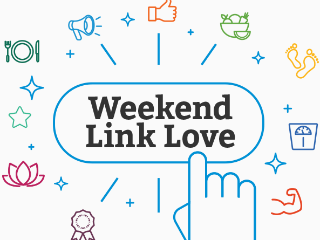 RESEARCH OF THE WEEK
RESEARCH OF THE WEEKExposure to common flame retardants may increase the risk of thyroid cancer.
Maple syrup extract enhances antibiotic efficacy.
Sex differences in brain structure.
After Tennessee shut down two nuclear plants and coal burning picked up the slack, infant health in the immediate vicinity suffered.
There’s no strong evidence that smartphones have lasting effects on how we think.
But just having one in the same room as you impairs your cognitive capacity.
Age isn’t an excuse. You can be 83 and still lift heavy and make gains.
Delaying the release of junk food from vending machines causes consumers to make healthier choices.
Linus Pauling’s smiling in his grave.
A successful reintroduction of the American chestnut would be a boon to wildlife.
Talking to preschoolers about their past and future selves helps them make better choices.
NEW PRIMAL BLUEPRINT PODCASTS

Episode 163: Dr. Gary Foresman: Host Elle Russ chats with Dr. Gary Foresman about hyperthyroidism.
Each week, select Mark’s Daily Apple blog posts are prepared as Primal Blueprint Podcasts. Need to catch up on reading, but don’t have the time? Prefer to listen to articles while on the go? Check out the new blog post podcasts below, and subscribe to the Primal Blueprint Podcast here so you never miss an episode.
INTERESTING BLOG POSTS
Why some people are choosing to eat at the hospital.
Is there such a thing as too many polyphenols?
How and why dolphins throw octopuses around before eating them.
How deep should you squat? It depends.
MEDIA, SCHMEDIA
Why even non-diabetics should consider wearing a continuous glucose monitor.
Rising carbon dioxide is greening the planet.
EVERYTHING ELSE
Without anyone really noticing, the alternative health sphere has revolutionized the way most people eat.
A huge competitive advantage for the Mongols was their meat-and-milk-rich diet.
THINGS I’M UP TO AND INTERESTED IN
Contest I have to share: Enter to win $100 to spend on Pura Vida bracelets along with 2 free canisters of the new PRIMAL KITCHEN® Collagen Fuel shake mix. You can also get 20% off your Pura Vida orders by using the code PRIMALKITCHEN20 at checkout.
Stat that blew my mind: Half of Americans are only responsible for 3% of health care spending.
Epigenetics study I found fascinating: Harms of blue light at night passed down to offspring.
Health paradox I’ve often wondered about: The toddler paradox.
Even though I missed April 1st: I’m getting a few of these for the office.
RECIPE CORNER
If you absolutely must have bread and you’re very low carb, try keto bread..
St. Patrick’s Day has come and gone, but paleo Irish stew remains a good choice.
TIME CAPSULE
One year ago (Apr 9– Apr 15)
12 Surprising Things You Can Do With Avocado Oil – It ain’t just for eatin’.
Why Breakfast Isn’t the Most Important Meal of the Day (for Everyone) – Skipping it won’t kill you, and it might help.
COMMENT OF THE WEEK
Make sure you drink it, though. Resist that strange compulsion so many have to shoot it up your colon.
“Well, there goes my weekend…”
– Mike S.

The post Weekend Link Love – Edition 447 appeared first on Mark's Daily Apple.
 [image error]
[image error]

April 8, 2017
Beef Rendang
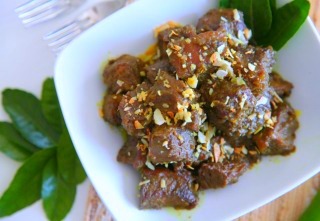 Rich in spices and slow-cooked in coconut milk, Indonesian Beef Rendang has a lot in common with beef curries from other countries. You get healthy fat from the coconut milk, plus spice and herb based antioxidants in every bite. Not to mention unbelievable flavor. These are not shy ingredients: rendang is all about making a big, bold statement.
Rich in spices and slow-cooked in coconut milk, Indonesian Beef Rendang has a lot in common with beef curries from other countries. You get healthy fat from the coconut milk, plus spice and herb based antioxidants in every bite. Not to mention unbelievable flavor. These are not shy ingredients: rendang is all about making a big, bold statement.
Imagine hot chile peppers, shallots, garlic, ginger, galangal, kaffir lime leaves, lemongrass, cloves and cinnamon—tamed only slightly by sweet, creamy coconut milk. The beef is braised in this intense fusion of flavors long enough to soak up all of the sauce. Rendang isn’t going to win any beauty contests, but when food tastes this good, who cares what it looks like?
Servings: 4 to 6
Time in the Kitchen: 2 hours (45 minutes prep time)
Ingredients

3 Thai or other hot chile peppers, chopped
4 shallots, roughly chopped
4 garlic cloves, roughly chopped
1 2-inch piece ginger, peeled and thinly sliced (5 cm)
1 2-inch piece fresh galangal, peeled and thinly sliced (5 cm)
½ teaspoon ground turmeric (1.2)
2 tablespoons coconut oil (30 ml)
2 pounds boneless beef chuck, seasoned with salt, cut into 2-inch/5cm pieces, or 2 pounds short ribs (900g)
1 13.5 fl oz unsweetened full-fat canned coconut milk (400ml)
6 kaffir lime leaves
2 stalks lemongrass (trimmed on the top and bottom), smashed or twisted to break open
4 whole cloves
1 stick cinnamon
1 teaspoon kosher salt (5 ml)
½ cup unsweetened coconut flakes (45 g)
Galangal and fresh kaffir lime leaves can be found in some Asian and Indian markets or well-stocked grocery stores. They can also be bought online. Extra kaffir lime leaves can be frozen and used for other recipes.
If fresh galangal can’t be found, dried (not powdered) can be used. For this recipe, soak 1 tablespoon dried galangal in hot water for 20 minutes until pliable. Chop as finely as possible with a knife before adding to the food processor with the other ingredients
Instructions

In a food processor, pulse the chiles, shallots, garlic, ginger, galangal and turmeric until a coarse paste forms. If needed, add 1 tablespoon water to help a paste form.
In a wide skillet or Dutch oven over medium heat, warm the coconut oil. Add the spice paste, stirring constantly until the spice mixture is warm and fragrant but doesn’t begin to brown, 3 to 5 minutes. Add the meat, stirring well to completely coat in the spice paste.
Add the coconut milk, lime leaves, lemongrass, cinnamon stick, cloves and salt. Bring to a boil. Reduce heat to medium low. Simmer the meat, uncovered, for 1 ½ hours. Stir frequently to make sure the coconut milk is not scorching to the bottom of the pot. (If using short ribs, pull the meat from the bone halfway through the cooking process and cut the short-ribs into 2-inch pieces so the meat is better covered by the coconut milk.)
While the meat is cooking, toast the coconut flakes in a dry skillet for a minute or two until lightly browned. Let cool. Grind the coconut flakes in a food processor or chop with a knife until fine. Set aside.
When the sauce is almost completely absorbed by the meat, and the meat is very tender, discard the cinnamon stick, lime leaves and lemongrass. Mix the coconut flakes in with the beef before serving.


The post Beef Rendang appeared first on Mark's Daily Apple.



April 7, 2017
It’s about Being Fit, Happy, and Healthy!
It’s Friday, everyone! And that means another Primal Blueprint Real Life Story from a Mark’s Daily Apple reader. If you have your own success story and would like to share it with me and the Mark’s Daily Apple community please contact me here. In fact, I have a contest going right now. So if you have a story to share, no matter how big or how small, you’ll be in the running to win a big prize. Read more here.
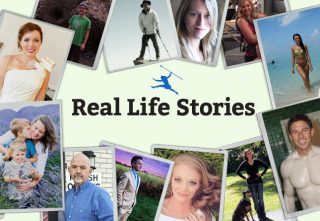 Knowing where to start when telling your story is a difficult point to figure out. After all I don’t want to bore you all with a blow by blow account of my life, but I am going to take it right back to the start, when I was brought kicking and screaming into the world, complete with a dislocated hip. I know what you’re thinking, that’s probably not so much of a big deal, just pop it back in there why don’t you?! Well this wasn’t exactly the plan. Most of my childhood was spent in and out of hospital due to my dodgy hip.
Knowing where to start when telling your story is a difficult point to figure out. After all I don’t want to bore you all with a blow by blow account of my life, but I am going to take it right back to the start, when I was brought kicking and screaming into the world, complete with a dislocated hip. I know what you’re thinking, that’s probably not so much of a big deal, just pop it back in there why don’t you?! Well this wasn’t exactly the plan. Most of my childhood was spent in and out of hospital due to my dodgy hip.
My first major surgery was at 6 months old, then again at 7 years old, when at a routine check-up the doctor realised my hip was hanging on by a thread. A new hip was created from other bits of bone from my leg, but the healing process of this left me in a wheelchair for the best part of a year, having to relearn how to walk and missing out on things like learning to swim and being fully active like my peers. The reason I am telling you this is that it really gave me a perceived limitation, one I have recently realised I was approaching all the wrong way.
Really if I am honest, my dodgy hip was the least of my problems. I could move, walk, run if I wanted and even learned to swim at the tender age of 25. I wore my two large scars (11cm and 13cm) on my hip like a tiger that earned her stripes. They didn’t bother me, the dodgy hip that has never regained its feeling didn’t really bother me, what bothered me was something else altogether.
 Growing up, I was from a disadvantaged area, and I can’t say that I was educated in the ways of nutrition and exercise…we were raised on potatoes. Through my teenage years and even more so in my early 20’s, I started to really notice that I wasn’t comfortable in my own body. Every time I ate, I got uncomfortable cramps and looked and felt like I was pregnant. I often got bouts of terrible nausea which left me lying in bed wondering should I just make myself sick to feel better. Attractive picture I have painted for you eh? I wonder how I managed to nab myself a boyfriend, never mind getting him to agree to marry this picture of beauty.
Growing up, I was from a disadvantaged area, and I can’t say that I was educated in the ways of nutrition and exercise…we were raised on potatoes. Through my teenage years and even more so in my early 20’s, I started to really notice that I wasn’t comfortable in my own body. Every time I ate, I got uncomfortable cramps and looked and felt like I was pregnant. I often got bouts of terrible nausea which left me lying in bed wondering should I just make myself sick to feel better. Attractive picture I have painted for you eh? I wonder how I managed to nab myself a boyfriend, never mind getting him to agree to marry this picture of beauty.
So off to the doctor’s surgery I go, hoping for him to give me some answers. Well, guess what….I left more confused than I went in. I explained my symptoms, and with no examination and minimal questions, I left 5 minutes later with a prescription for tablets which decreases the amount of acid produced in the stomach. But hey, I was going to gobble them up, because a doctor knows what he’s talking about, right? Wrong. Back to the doctors I go again.
 This time, I get a diagnosis of Irritable Bowel Syndrome. Great, right? Now I can actually make a plan of action. Wrong. I’ve left once more confused and with now two sets of tablets for different reasons….one pill to prevent spasms and one for when that failed to work. Fan-tas-tic. The problem is that quite frankly I don’t want to take 6 tablets a day and have to schedule eating times. I want to eat when I am hungry and not take anti-spasmodic pills when I have had a spontaneous meal.
This time, I get a diagnosis of Irritable Bowel Syndrome. Great, right? Now I can actually make a plan of action. Wrong. I’ve left once more confused and with now two sets of tablets for different reasons….one pill to prevent spasms and one for when that failed to work. Fan-tas-tic. The problem is that quite frankly I don’t want to take 6 tablets a day and have to schedule eating times. I want to eat when I am hungry and not take anti-spasmodic pills when I have had a spontaneous meal.
Now, I work 40 hours a week, so another trip to the doctors really grinds my gears, because I just don’t have the time. But third time lucky (I was hoping). The locum doctor indeed confirmed my diagnosis of IBS, and this time offered some extra advice. To be fair, she was a little more informative but I still didn’t really understand what this meant for me. So I just continued on with how I always did and just sucked in my swollen belly in to appear thinner, took painkillers for when the cramps got too much and came home every day to get changed into my husband’s tracksuit bottoms that accommodated my circular disposition.
 Fast forward to June 2016 when I attended an awards ceremony and entered a charity raffle, and won, yay go me! What I won was a free session with a Personal Trainer (none other than Fionnbharr Toolan of Virtu Belfast– Irish, European and World Kettlebell Champion – pretty impressive wouldn’t you say). Chatting to my husband, he actively encouraged me to take on the session, knowing how unhappy I was at the time with my physical appearance.
Fast forward to June 2016 when I attended an awards ceremony and entered a charity raffle, and won, yay go me! What I won was a free session with a Personal Trainer (none other than Fionnbharr Toolan of Virtu Belfast– Irish, European and World Kettlebell Champion – pretty impressive wouldn’t you say). Chatting to my husband, he actively encouraged me to take on the session, knowing how unhappy I was at the time with my physical appearance.
So, off I go, nervous as hell about what this was going to entail. After all I had a limitation of a dodgy hip remember. Well guys, I cannot tell you how much my perception of exercise changed after leaving that first session with Fionn and the sessions since. It wasn’t all cardio, high intensity, sweat inducing workouts….instead it was mobility work, strengthening muscles that I didn’t know I had. I started lifting weights, a thing that I firmly believed was only for men who watched themselves in the mirror grunting and panting. I could see serious progress. I was, and continue to be hooked.
But for me, lifting heavy things and being able to move in ways I thought impossible due to my ‘limitations’ was secondary, compared to the amazing change that the paleo diet has had on my life. When I told Fionn about my IBS, he went off and did a little research and talked to me about why he felt I should turn to a paleo lifestyle, and he was the one that pointed me in the direction of The Primal Blueprint. This was the first time someone actually took the time and effort to explain how my body used food and nutrients, and how it was different for me as a sufferer of IBS.
 Fionn made me write a food diary, monitored it weekly (which was daunting but oh so necessary) because let me tell you something, I knew nothing about nutrition. All the stuff I knew – the stuff I believed to be healthy (the brown rice, the boiled potatoes, the low fat yogurts), was the very thing blowing little holes in my gut. I had to basically rewrite all my knowledge and educate myself in the ways of primal living. I cannot express how much it has changed my life, and I genuinely mean it. There is no bloating, no nausea, no cramping and I can spend the whole day in my own clothes (bonus).
Fionn made me write a food diary, monitored it weekly (which was daunting but oh so necessary) because let me tell you something, I knew nothing about nutrition. All the stuff I knew – the stuff I believed to be healthy (the brown rice, the boiled potatoes, the low fat yogurts), was the very thing blowing little holes in my gut. I had to basically rewrite all my knowledge and educate myself in the ways of primal living. I cannot express how much it has changed my life, and I genuinely mean it. There is no bloating, no nausea, no cramping and I can spend the whole day in my own clothes (bonus).
My confidence has seriously grown and it’s forced me into discovering new and wonderful ingredients out there in the world. The exercising bit for me is easy (not literally, Fionbharr works me pretty hard), but the psychological change I had to make to my whole entire lifestyle was immense. But do I regret it? Absolutely not. I’ll accept the weird looks when I sit down to steak and nuts for breakfast, I will accept the comments about eating ‘rabbit food’ for lunch instead of the bowl of mashed potato, I will even accept the eye rolls when someone doesn’t understand why I do and advocate for the primal life.
For me, it’s not about a fad diet, or being skinny or thin, it’s about being fit, happy and healthy. For me – I don’t do the ‘Paleo Diet,’ I do the Paleo Life.

The post It’s about Being Fit, Happy, and Healthy! appeared first on Mark's Daily Apple.



April 6, 2017
Dear Readers: A Giveaway for Your Thoughts…
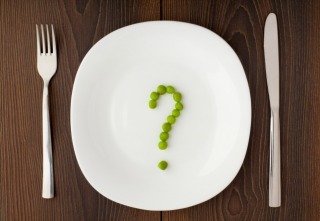 I’ve got nutrition on the mind today. And I’m curious about your thoughts. Health trends and topics have evolved considerably since I first started this blog a decade ago. “Fringe” foods then are now thriving businesses. What was once nutrition heresy is today on the cover of mainstream publications. They’re far from standard, but Primal principles are getting more attention. Where do we go from here? And what’s for dinner? You tell me….
I’ve got nutrition on the mind today. And I’m curious about your thoughts. Health trends and topics have evolved considerably since I first started this blog a decade ago. “Fringe” foods then are now thriving businesses. What was once nutrition heresy is today on the cover of mainstream publications. They’re far from standard, but Primal principles are getting more attention. Where do we go from here? And what’s for dinner? You tell me….
Today I want to know what you want out of MDA nutrition commentary, dietary research, and recipe development. What do you want to learn? What interests you? And since I get some form of the question often, what do you want to know about my own personal day-to-day diet?
I’ve covered a lot of topics and served up a lot of Primal recipes over the years, but there are plenty more to be explored. Tell me what you think should come next.
And to give you some incentive in exchange for your thoughts, I’ll give you a shot at winning some free stuff (because, why not?)
The Contest
“What nutrition question or recipe/cooking request do you have?”
My articles are constantly informed by the feedback of my readers. In the comments section below, tell me one nutrition related topic you’d like to see covered, one dietary question you’d like to see answered, or one recipe idea you’d love to see us share on Mark’s Daily Apple. I’m leaving this fairly open ended. No idea is too small or big.
A winner will be chosen at random. Agreeing with other people is allowed (and encouraged), but only the idea comments will be counted for drawing purposes.
The Prize
[image error]A prize package containing the following:
—A canister of my brand new PRIMAL KITCHEN® Vanilla Coconut Collagen Fuel (FYI: 20 grams of protein and more collagen than 2 cups of bone broth per serving)
—A box of PRIMAL KITCHEN® Coconut Cashew Bars
—A bottle of Primal Probiotics
The Deadline
Midnight (PDT), tonight!
Who’s Eligible
Everyone. We’ll ship this prize package anywhere in the world!
There’s More!
While only one winner will be chosen out of this batch, I invite you to also enter to win at another great contest I have going in partnership with Pura Vida, the cause-based bracelet company. Prizes include 2 canisters of PRIMAL KITCHEN® Vanilla Coconut Collagen Fuel and $100 to spend on Pura Vida bracelets. Enter here.
But wait!
Even if yours isn’t the random comment chosen to win, I do have a deal for anyone to take advantage of. (I’m THIS excited about the Collagen Fuel—a product close to my personal mission, not to mention my daily routine.)
Order a canister of PRIMAL KITCHEN® Vanilla Coconut Collagen Fuel and get a 6-Pack of my Coconut Cashew Bars FREE (one per person). It’s my Collagen deal of the year.
Thanks in advance to everyone that offers an idea. I’ll see what I can do to serve up answers (and recipes) to your Primal food interests in the coming months! Take care, everybody.
The post Dear Readers: A Giveaway for Your Thoughts… appeared first on Mark's Daily Apple.



April 5, 2017
How to Augment and Support Your Natural Detox Capacities
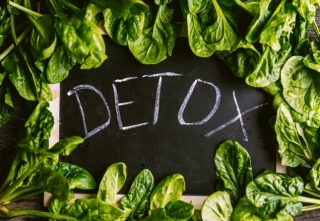 Conventional wisdom has decreed that “detox” is a myth. They’re not even sure if toxins even exist, as far as I can tell. On the other side, you’ve got detox gurus prescribing cayenne-maple-lemon tea and glasses full of charcoal water as cures for essentially everything. Where’s the truth lie?
Conventional wisdom has decreed that “detox” is a myth. They’re not even sure if toxins even exist, as far as I can tell. On the other side, you’ve got detox gurus prescribing cayenne-maple-lemon tea and glasses full of charcoal water as cures for essentially everything. Where’s the truth lie?
First, detoxification does exist. It’s an established concept, after all, with its very own spot in the dictionary. When we come into contact with toxins—compounds that pose a threat to our healthy homeostasis—we must remove or nullify them. That’s detoxification.
Popular conceptions of how detox works, however, are inaccurate. Both sides are wrong. Both sides are flailing around a false narrative. The conventional side, the skeptics, are attacking a straw-man—that our bodies are passive recipients of toxicity, the damsel tied to the tracks awaiting the oncoming toxin train, and only this special proprietary blend of herbs and spices can sever the bonds. The detox fanatics, meanwhile, overstate their case, with frequent references to “flushing” and “die-off.” They seem to think that detox is about using outside agents to impose order on the body from the top down.
In reality, the body comes equipped with detoxification capabilities. We use the liver, kidneys, and various endogenous antioxidants to remove and/or nullify dangerous compounds that enter the body. And we can improve the functioning of those capacities, either by actively supporting them with necessary precursors or by getting out of their way.
Feel the heat.
Applying heat “just feels good,” they say. Saunas are a placebo, they say. There’s no evidence they actually help you detox anything, they say. It’s an indulgence we’re attempting to justify, they say. And you’re certainly not sweating out any toxins.
But wait…
Exposure to extreme heat increases something called heat shock proteins, or HSPs. HSPs have a range of beneficial hormetic effects on our detoxification capacity. They trigger compensatory adaptations and activate antioxidant defenses in the blood of healthy volunteers. They even increase regeneration of the body’s main detoxifying organ—the liver—after it’s been damaged.
As for that sweating claim, sweat contains contains bioaccumulated toxins. BPA shows up in sweat, for example, even when it doesn’t show up in the blood or urine. Sweat also contains certain phthalate compounds and their metabolites, none of which we want. Sweat also contains arsenic and lead in people exposed to high levels of the metals. Sweating may even improve the function of another important detoxification organ—the kidney—by restoring nitrogen excretion in people with kidney disease. In one study, police officers with chronic illnesses caused by exposure to high levels of meth lab chemicals experienced major improvements after sauna therapy.
Drink coffee.
Coffee is consistently linked to lower rates of type 2 diabetes, which many researchers suggest begins with damage to the liver. More recently, coffee was shown to undo alcohol-related liver damage. And high coffee consumption appears to protect against liver cancer by reducing liver damage. A damaged liver cannot perform its designated functions as well as it should. A damaged liver cannot process, metabolize, and render inert the toxins it’s supposed to be handling.
Moderate coffee consumption also increases serum levels of glutathione, a major player in detoxification.
Make sure you drink it, though. Resist that strange compulsion so many have to shoot it up your colon.
Eat cruciferous vegetables.
We all know crucifers like broccoli, cabbage, Brussels sprouts, and cauliflower are “good for us,” but why? One big reason is that they’re good sources of sulforaphane, a potent activator of a little-known, but extremely important antioxidant called quinone reductase. Quinone reductase protects cells from carcinogenic or toxic insults, and it also helps conduct the activity of glutathione.
Dr. Rhonda Patrick recommends broccoli sprouts, which have up to 100 times the sulforaphane of mature broccoli. A daily broccoli sprout drink was able to quickly and sustainably nullify airborne pollutant-derived oxidative stress in a group of Chinese adults.
Eat collagen.
Glycine, the primary amino acid in collagen, is essential for detoxifying methionine, an amino acid found primarily in muscle meat and eggs. The more meat/eggs you eat, the more collagen you need to replenish.
That means eating collagenous material like cartilage, gristle, and bone broth, or eating dedicated collagen supplements. (I’ve made this a daily priority for myself for quite a while now, and I try to make it easier for others to implement in their diet.)
For heavy metals, try chelating agents.
EDTA, or ethylenediamine tetra-acetic acid, is a synthetic amino acid with proven efficacy against heavy metal toxicity. Once administered, EDTA literally dissolves heavy metals in the body. EDTA-bound metals are highly water-soluble, so they’re easy to excrete.
It’s extremely similar to how detox gurus talk about magical detox protocols, except it actually works. One recent study that actually sought out to disprove the chelating effects of EDTA ended up getting a massively positive result. There’s even evidence that EDTA chelation can protect against other diseases, like heart disease.
Support glutathione production.
Glutathione is the master antioxidant. It plays a role in the detoxification of most every toxin that enters your body, from alcohol to BPA to airborne pollutants.
Fortunately, there are many ways to support your glutathione status:
Eat polyphenols.
Take NAC.
Drink raw milk or eat raw egg whites.
Take whey protein.
Eat crucifers (again).
Support cytochrome p450 activity.
Cytochrome p450 is a class of enzymes that, among other tasks, detoxifies incoming drugs and carcinogens. As with glutathione and the other antioxidants, cytochrome p450 responds to certain dietary components.
Crucifers boost cytochrome p450 activity, while apiaceous vegetables (carrots, parsley, celery) inhibit it. This doesn’t mean that carrots will toxify you. They’re still good to eat. Just don’t eat them in the hope of activating cytochrome p450.
Dietary flavonoids—plant phytochemicals found in foods like chocolate, red wine, tea, berries, and pretty much everything—can also alter cytochrome p450 activity. Some will raise it, some will lower it, but the important thing is that flavonoids in general have a positive effect. Just eat a wide variety of whole foods and you’ll come out ahead.
Support your liver.
The liver is a chemical processing plant. If something’s being detoxified in your body, the liver is probably involved. There are several things you can do to keep the liver healthy:
Avoid refined omega-6 polyunsaturated oils. Get your PUFAs from fish, eggs, animals, and nuts.
Don’t eat refined sugar.
Don’t drink too much alcohol, and when you do, eat some saturated fat with it and really minimize your polyunsaturated fat intake the day of. Consider protecting your liver with my New Year’s Eve protocol, if you’re really worried.
Eat egg yolks often and try some liver once in awhile. Both are high in choline, which our livers require to process fats and function properly. We can also make choline from methionine, an amino acid found in animal products, but it’s best to get plenty of both. And the more methionine you eat, remember, the more collagen you need.
Support your kidneys.
The kidneys excrete many of the toxins you accumulate.
Protein gets a bad rap when it comes to kidney health, but the real culprit appears to be sugar, particularly fructose. Compared to glucose, it has a far more adverse effect on the kidneys. Metabolic syndrome also usually precedes kidney failure.
If you have bad kidney function already, limit protein intake until it’s back on track. But rest assured that even high protein intakes pose no real threat to healthy kidneys.
Support your gut.
Having good gut health is paramount for detoxification. For one, a leaky gut allows unwanted compounds into circulation to disturb homeostasis. Those are toxins. It may not be the kind of “toxin” most people think of when they hear the word “detox,” but bacterial endotoxin, allergenic proteins, and other irritants that take advantage of a leaky gut wall can do serious damage. To boot, gut bacteria modulate xenobiotic metabolism.
As you can see, there’s nothing magical about detoxification. You’re not introducing some super food that hones in on and eradicates the toxins coursing through your blood. You aren’t physically flushing them out from your colon. There’s no brute force involved. You’re simply supporting and, in some cases, augmenting the natural detoxification pathways human bodies have been using for hundreds of thousands of years.
This also means that detoxification is an ongoing process. It’s not a one-and-done deal. You don’t “do a cleanse” every fortnight and forget about it until the next. You have to maintain and be consistent.
What say you, readers? What do you think of my take on “detox”? As always, I’m sure I’ll have pissed off people from both sides of the argument. I wouldn’t have it any other way. It’s how good conversation gets started.
More importantly, what are you taking from this post? What will you change—or make sure to maintain—about your lifestyle?
If I missed anything, please let me know. What are some other legitimate ways to augment one’s detoxification ability?
Thanks for reading, everyone. Take care.
The post How to Augment and Support Your Natural Detox Capacities appeared first on Mark's Daily Apple.



Mark Sisson's Blog
- Mark Sisson's profile
- 199 followers







